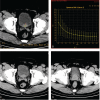Application of dual-energy spectral CT imaging in differential diagnosis of bladder cancer and benign prostate hyperplasia
- PMID: 28033269
- PMCID: PMC5207565
- DOI: 10.1097/MD.0000000000005705
Application of dual-energy spectral CT imaging in differential diagnosis of bladder cancer and benign prostate hyperplasia
Abstract
The aim of this study was to explore the clinical value of dual-energy spectral CT imaging in the differential diagnosis between bladder cancer and benign prostate hyperplasia (BPH).We retrospectively analyzed images of 118 patients who received pelvic dual-energy spectral CT imaging. These patients were later confirmed to have bladder cancer in 61 patients and BPH in 57 patients. CT values of the 2 lesion types from 40 to 140 keV were measured from the monochromatic spectral CT image to generate spectral HU curves. The slope of the spectral curve and the lesion effective atomic number were calculated. The measured parameters were analyzed with independent-sample Mann-Whitney U test.There was a statistically significant difference in CT value between the 2 groups from 40 to 90 keV, with the biggest difference at 40 keV (median and interquartile range: 83.3 HU and 22.9 HU vs 60.6 HU and 16.7 HU, Z = 5.932, P < 0.001). The slope of the spectral HU curve for bladder cancer was markedly higher than that of BPH (median and interquartile range: 0.48 and 0.23 vs 0.26 and 0.22, Z = 5.162, P < 0.001); the difference in effective atomic number (median and interquartile range: 7.99 and 0.21 vs 7.80 and 0.20, Z = 5.233, P < 0.001) was also statistically significant.Dual-energy spectral CT imaging provides high sensitivity and specificity for differentiating bladder cancer from benign prostate hyperplasia.
Conflict of interest statement
The authors declare no competing financial interests.
Figures




References
-
- Siegel R, Ma J, Zou Z, et al. Cancer statistics, 2014. Cancer J Clin 2014;64:9–29. - PubMed
-
- Chen W, Zheng R, Baade PD, et al. Cancer statistics in China, 2015. Cancer J Clin 2016;66:115–32. - PubMed
-
- Bushman W. Etiology, epidemiology, and natural history of benign prostatic hyperplasia. Urol Clin North Am 2009;36:403–15. - PubMed
-
- Gosling JA, Kung LS, Dixon JS, et al. Correlation between the structure and function of the rabbit urinary bladder following partial outlet obstruction. J Urol 2000;163:1349–56. - PubMed
MeSH terms
LinkOut - more resources
Full Text Sources
Other Literature Sources
Medical

